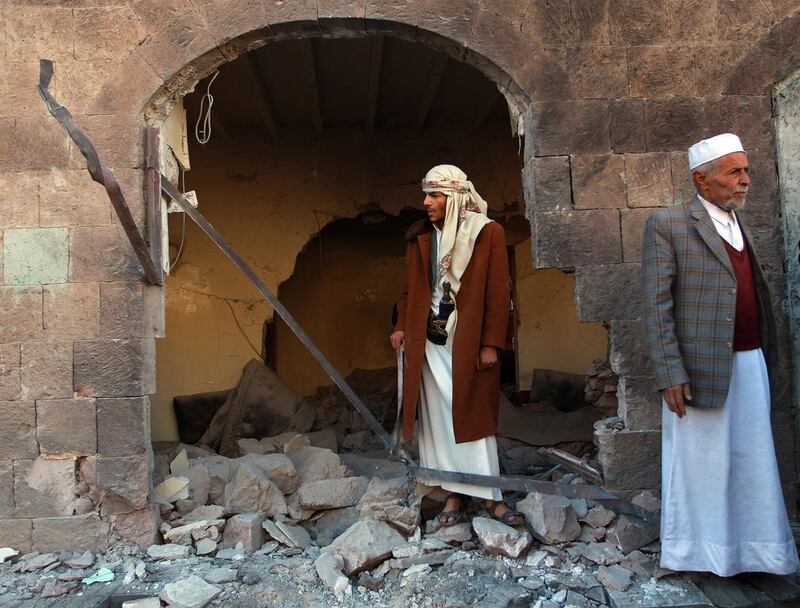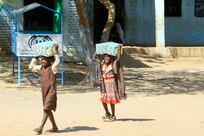CAIRO // Al Qaeda’s branch in Yemen is surging in strength, finding new support and recruits among the country’s Sunni tribesmen, in a backlash to drone strikes and the rise to power of Shiite rebels who have taken over the capital and other parts of the country, tribal leaders and Yemeni officials warn.
The militants’ rise comes after months of being squeezed by multiple challenges. Early last year, US drone strikes followed by Yemeni ground troops helped Yemen destroy a key Al Qaeda base in the remote mountains of the impoverished, unstable nation. The past year, Al Qaeda has also faced fierce competition from the Middle East’s new militant powerhouse, ISIL, which has sought to make inroads into Yemen.
But the expansion of the Shiite rebels known as Houthis has been a godsend for Al Qaeda in the Arabian Peninsula, as the branch of the terror network in Yemen is called. The turmoil in Yemen has taken on a sharply sectarian tone, pitting Sunnis against Shiites, to the benefit of Sunni Al Qaeda. And while the group has lost some prominent figures in drone strikes over past years, deaths of members of prominent tribes in the strikes have pushed tribesmen toward the militants.
Over the long term, the United States’ years-long campaign to put down the Al Qaeda branch is likely to suffer, warns Bill Roggio from Long War Journal, which chronicles militant activities.
As Al Qaeda gains ground locally in Yemen, that strengthens its ability to carry out attacks abroad against the US, its main priority.
“The local fuels the external. They will become more dangerous the more they draw local support,” Mr Roggio said. As Washington’s ally in Yemen, president Abdrabu Mansur Hadi, gets weaker, US ability to strike Al Qaeda “will diminish over time after losing its partner,” he said.
Backed by deposed president Ali Abdullah Saleh, Houthis pushed out of their enclaves in northern Yemen and took over the capital Sanaa in September. Mr Hadi’s government has been virtually under its thumb since. Houthi forces have since spread over eight of Yemen’s 21 provinces, taking over security powers in many cities and towns, with government officials and forces split in loyalties, either stepping aside or grudgingly co-operating with them.
At first the fight between Houthis and their opponents was largely a split along political and tribal lines. But now as the Shiite rebels push into largely Sunni regions of central Yemen on a declared campaign to fight Al Qaeda, the conflict has taken on a sharply sectarian nature of Sunni vs Shiite, to the benefit of Sunni Al Qaeda. The militants and their allies have responded with a guerrilla campaign of suicide bombings and other attacks against the Houthis.
Houthi power “is only increasing Al Qaeda membership,” an Al Qaeda member in Yemen said. He said the group’s strategy is to exploit the Houthis’ overextension from their base in the north, “drag them into a long war, and force them to retreat.”
The city of Radaa in the centre of the country, one of the heaviest battlegrounds, showcases how Al Qaeda is capitalising on the fallout.
Bombings hit Houthi positions in Radaa nearly every night, killing dozens in past weeks. Local tribes give Al Qaeda militants safe passage through their areas to strike the Shiites, said Ali Abu Sarima, a local tribal leader who opposes both the Houthis and Al Qaeda.
The city is a longtime stronghold for Al Qaeda. Its militants briefly took it over in 2012 but were driven out by Yemeni troops backed by local tribesmen. Now, because of resentment of the Houthis, some tribesmen are turning to back Al Qaeda, local tribal figures say.
“It’s a matter of vendetta against Houthis. Tribes can even ally with the devil,” Sheikh Ahmed Al Jabri, a tribal leader in Radaa, said.
Residents increasingly see Al Qaeda as “the last fortress protecting Yemen’s Sunnis” against the Houthis, said a media official in the government of Bayda province, where Radaa is located.
“This will end up with blocs of Sunnis versus Shiites ... while state power evaporates,” the official said
He and others in the area said there is also a perception that the US is working with the Houthis, amid claims that drone strikes have hit militants while they are fighting the Shiite rebels. Washington has spoken out against the Houthi power grab. Still, Al Qaeda has sought to fuel that perception. In a recent online Q&A with reporters, Al Qaeda in Yemen’s military chief Nasr Al Ansi called the Houthis the “intelligence arm” of the US.
Also turning to Al Qaeda are members of the Islah Party, the Yemeni branch of the Muslim Brotherhood, after Houthi fighters defeated the party’s militias during their advance toward Sanaa and the party largely sought political resolutions not fighting the rebels, said analyst Ahmed Al Zarqa.
Inside Yemen, Al Qaeda in the Arabian Peninsula’s strongest point came in early 2011 when it seized several cities in the south and created a virtual government of its own, with religious courts and administrators overseeing public services. But they were beaten back by a heavy Yemeni military offensive backed by the US, scattering the militants into various remote strongholds.
In April, it suffered a new blow when Yemeni troops backed by US drone strikes took a major Al Qaeda base hidden in the mountains of the south near the town of Mahfad. After that defeat, the group’s “Security Committee” attempted to improve security for group’s members by distributing leaflets to its followers with instructions on how to avoid drone strikes — advising them to run to a new position as soon as they hear a drone overhead on the theory that they have 12 seconds before a missile strikes.
The group also tightened its measures against spies, after capturing a number of alleged informants whom they executed, after putting them before cameras to give details on how they planted electronic chips on militants to help target strikes. New instructions to Al Qaeda members advise them not to take gifts or laptops from anyone suspicious and new recruits are more strictly vetted now to weed out potential spies.
The group has spread to a presence in 12 of Yemen’s 21 provinces including the capital, according to 2013 American Enterprise Institute report. The Al Qaeda member put it even higher — in 16 provinces.
Yemeni analyst Mohammed Abdel Aziz compared Yemen to Iraq of the 2000s, when the rise of Shiites to power fuelled Al Qaeda’s branch there in a brutal sectarian war. The group’s aim is over time to erode the power of the government it sees as infidel.
“Al Qaeda has been biting the fringes of the Yemeni state,” he said. “They keep biting the fringes, like small foxes attacking an elephant from all directions,” he added.
* Associated Press





